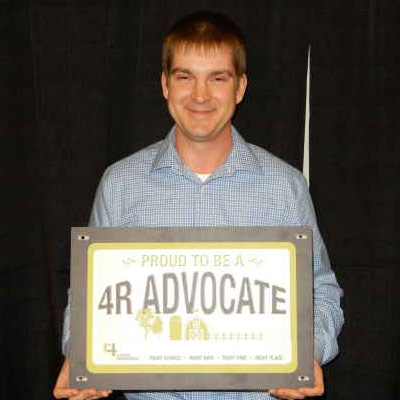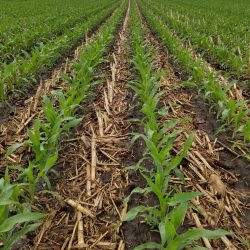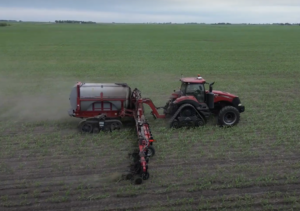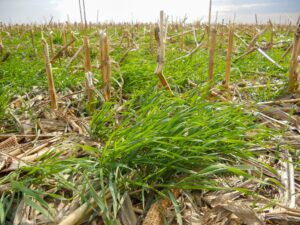By: 4R Plus
July 2019

Jones County, Iowa, farmer Darin Stolte is passionate about nutrient stewardship. He continually looks for ways to feed the plant more efficiently to maximize his input investment. Since being named a 4R Grower Advocate in 2016 by The Fertilizer Institute, he has added strip-till and cover crops to the farm and reports the yield curve has accelerated.
“I added conservation practices because I realized we need to stop the erosion and improve the water infiltration,” he said. “Farms take on excess water so much easier when reduced tillage is used. Now the water doesn’t run off cornfields that have been strip-tilled or soybean fields that have been no-tilled.”
In 2012, Stolte began a 4R program that assured he was using the right fertilizer source at the right rate, the right time and the right place for the crop to maximize benefits. “My yields instantly skyrocketed compared to when I broadcast nutrients,” he said. “I was using some of the 4Rs previously, like split-applying nitrogen, but now every year I am looking to fine-tune nutrient management by using new products and precision technology.”
Instead of using traditional fertilizers like he has in the past, Stolte uses higher-quality nutrients based on zone soil sampling and crop removal rates. “We’re going further than applying nitrogen, phosphorus and potassium in one pass,” he explained. “By splitting the applications we give the plant access to the right amount of nutrients to achieve maximum uptake. Broadcasting nutrients across whole fields can lead to nutrients leaving the farm. Precisely placing nutrients in strips allows me to maximize my investment and my yield curve continues upward.”
John McGillicuddy, an independent agronomist with McGillicuddy Corrigan Agronomics, oversees soil testing on Stolte’s farm. “We use all the information that is available, such as satellite imagery, yield monitor data, information from soil surveys and elevation data to define the zones,” said McGillicuddy. “That provides the farmer with a more accurate picture. Changing fertilization and plant populations based on actual changes in the soil provides the best return on a farmer’s investment.”

“The crop doesn’t care how many toys you have. It cares how it’s being fed,” Stolte said. “I am trying to do more with less and be sustainable so future generations can make a living on this land. By using nutrients wisely and adding conservation practices I accomplish this. Utilizing the 4Rs is the best return on investment I have on my farm.”
Stolte said incorporating strip-till into the protocol improves soil health and provides a precise placement for nutrients. “I had a farm last year that was hilly and I used a high-quality fertilizer precisely placed in the strips. I couldn’t believe my eyes when I watched the yield monitor,” he said.
“I like that I’ve only been doing strip-till for two years and it already supports the equipment better. I see even better benefits where cover crops were seeded,” said Stolte. “The structure of the soil is better. My goal was to add these practices and maintain an upward yield curve and the pace of yield improvement actually climbed the first year.”
After just two years of using strip-till and cover crops, Stolte is a firm believer in an integrated 4R Plus approach. “I encourage farmers to seek knowledge to do things better. It’s through my failures that I’ve been able to make adjustments to be where I am today,” he said. “You have to start somewhere and have the attitude to keep making it better. I go to as many educational events as I can and each time I bring something back to the farm that I learned.”
Stolte is thinking about what changes he will make for the 2020 crop year. He plans to modify the planter in order to place nutrients in two bands instead of one in the strip. “I want to know if this is a better way and will have two years of data to compare it to,” he said. “I attribute my accelerating yield curve to the 4R Plus plan I continue to modify each year.”



